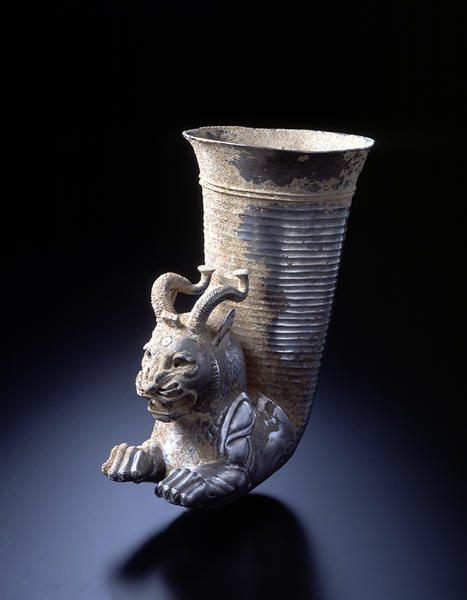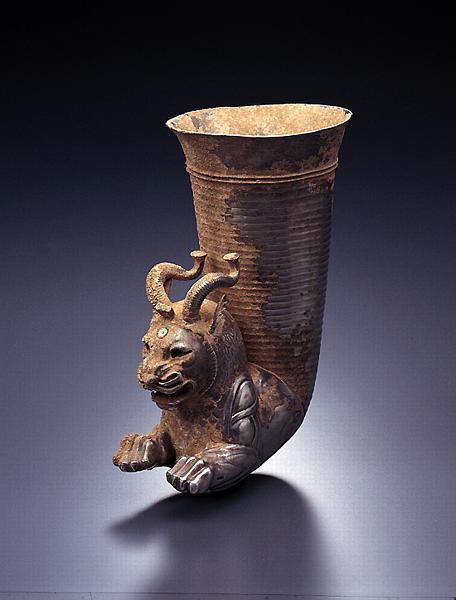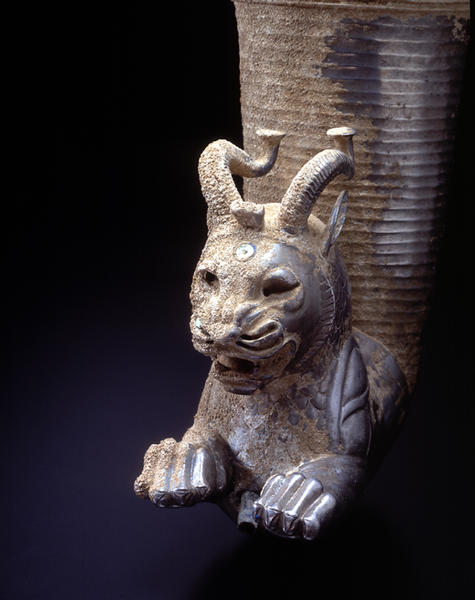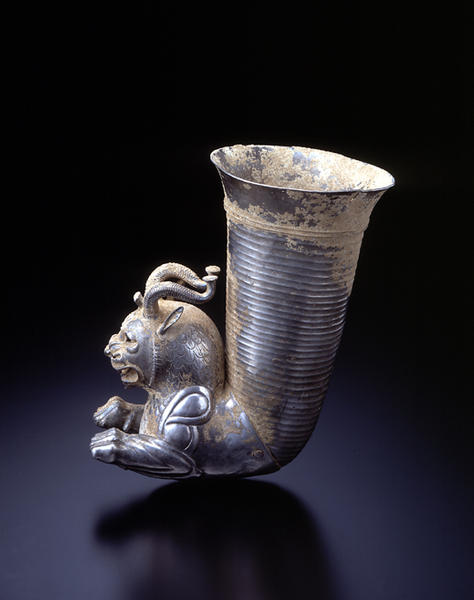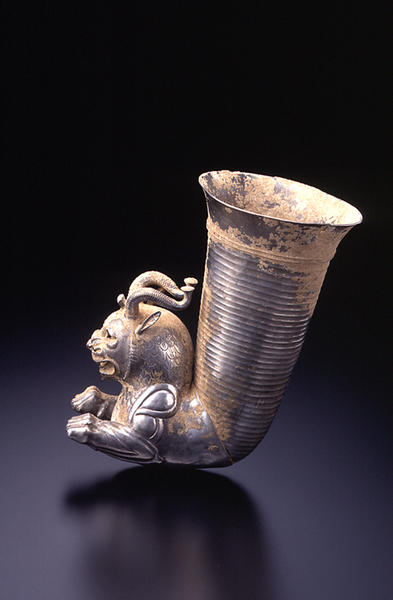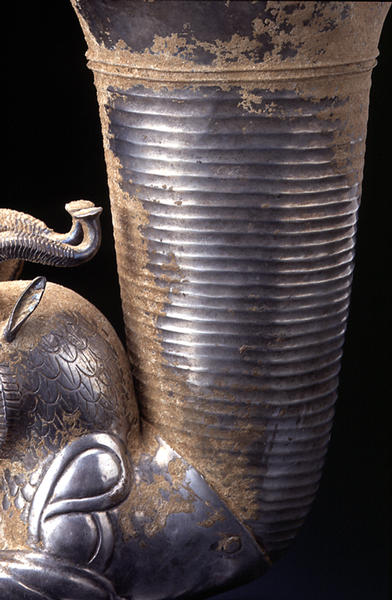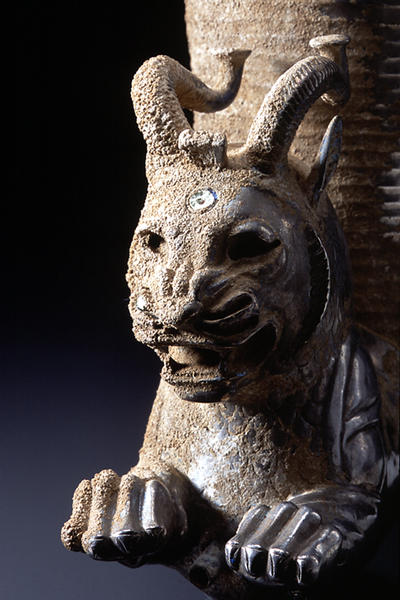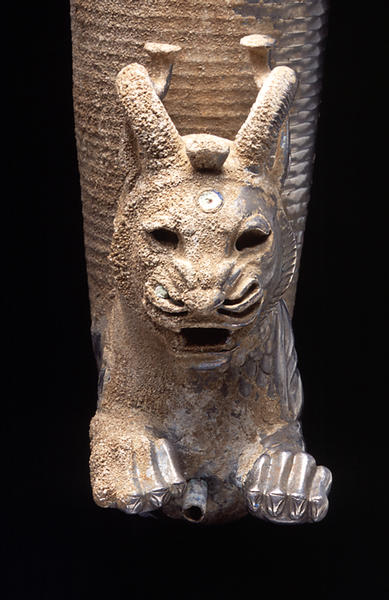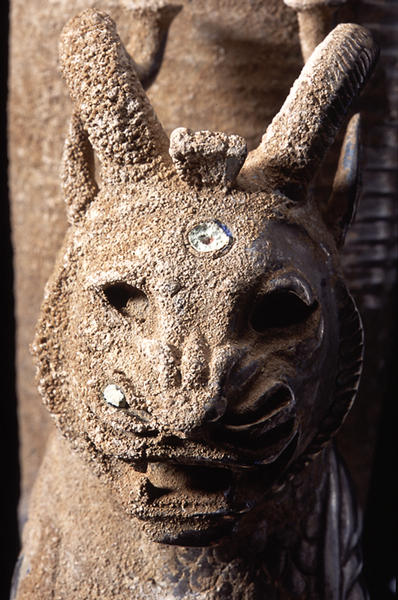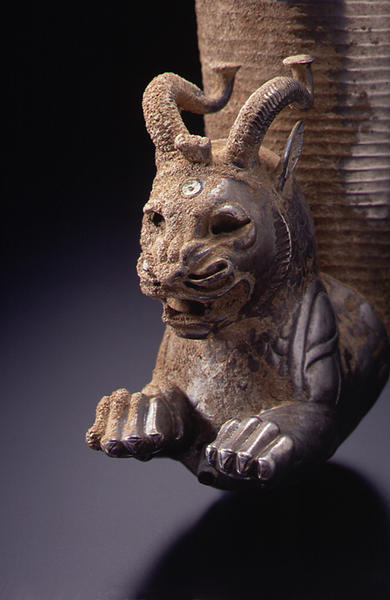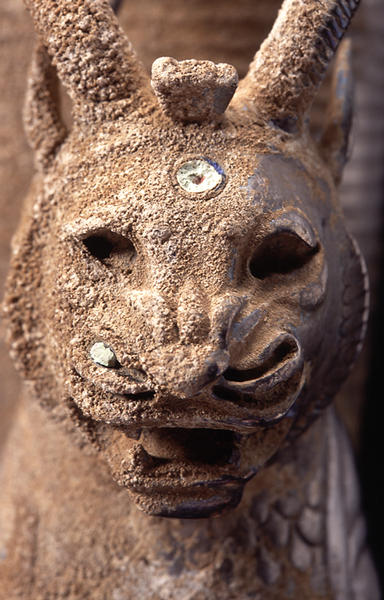Rhyton with a Horned-lion Protome
- Persia, Achaemenid period
- 4th century B.C.
- Silver with vitreous paste inlays
- H-17.5 D-10 W-5.2
Catalogue Entry
The rhyton with an animal protome-a horn for liquids to which the depiction of the forepart of an animal was attached, at a right angle-was a vessel form that came more widely into use in the Near East during the Achaemenid period (about 538-331 B.C.). The protome of this rhyton depicts the forequarters of a fantastic hybrid creature, a leonine beast with curved blunt horns and upright ears, probably meant to represent a wingless lion-griffin. It is shown with open mouth and wrinkled muzzle, snarling, its foreleg muscles tense and claws extended. The body of the beaker is horizontally fluted in typical Achaemenid style. A finely worked chevron ribbing covers the horns of the animal. Raised double-lobed motives define the creature's haunches. Its neck and chest are engraved with an overlapping featherlike pattern. On the neck this pattern has a narrow pointed rib in the center of each individual segment; whereas on the chest the segments are empty.
This extraordinary vessel may be compared with a similar Achaemenid-period silver-gilt rhyton with a griffin protome found in Erzingan, Armenia, and now in the British Museum.1 Several other silver vessel and objects of luxury from the same period found at this site are also in the British Museum's collection, and it is possible that these were the property of a wealthy satrapal court. Other Achaemenid silver objects that accompanied the horned-lion rhyton and are now in the Shumei collection include a rhyton with a calf-protome, two lobed libation bowls, a lidded flask, a ladle with lion ornaments, and a large lobed bowl. The last named bears inscriptions in Old Persian and Late Babylonian which state that it was made for King Artaxerxes. This might refer to any one of three Achaemenid rulers known by that name who reigned in the fifth and fourth centuries B.C. The horned-lion fits well within the tradition of Achaemenid style in sculpture. Its snarling face recalls similar beasts on protome capitals and reliefs at Persepolis; and the double lobed B-shaped patterns on its haunches are likewise found on relief friezes of striding lions in the Hall of a Hundred Columns at the same site.2 At Achaemenid Susa, lions with double-lobed muscle patterns and winged lion-griffins are depicted in glazed brick reliefs; and horned-lion heads are repeated on glazed tile designs.3
Details of the Shumei horned-lion rhyton present us with numerous parallels in Achaemenid decorative arts as well. A magnificent gold rhyton in the Iran Bastan Museum in Teheran has a horizontally fluted beaker fitted to a protome of a snarling lion with large, elegantly curved, separately attached wings.4 A gold rhyton in the Metropolitan Museum of Art has as its protome a similar leonine creature with a crested mane and small engraved wings emanating from B-shaped muscle outlines on its haunches.5 The ibex protome on a silver rhyton also in the Metropolitan Museum has a ribbed pattern on its horns similar to that of our horned-lion.6
One unusual feature of this Shumei rhyton is the elaborately made circular inlay on the lion's brow. If meant as a significant emblem, it may suggest an eastern provenance for the vessel. We find the urna, an auspicious mark, on the brows of both Buddhist and non-Buddhist deities in the imagery of the Kushan Empire, which encompassed Afghanistan in the first three centuries A.D. It is possible that this symbol was already known and utilized in an eastern Iranian environment during the Achaemenid era.7 Although the horned-lion has an animal not a human form, it must have represented a powerful supernatural entity. The most dramatic scenes found at Persepolis show royal figures stabbing an array of rampant, attacking hybrid beasts, a winged lion-griffin among them.8 A similar motif appears on the decoration of an Achaemenid silver bowl in the Museum's collection (fig. 1). It would appear that such fantastic creatures could serve as powerful protectors in some instances, and at other times personify dangerous adversaries of the king.
This vessel was created by hammering, engraving, soldering and riveting together its separately made parts. The upright beaker with its flared rim is attached to the horned-lion protome by five rivets. The lion's forelegs, horns, ears, forehead ornament and spout are soldered to the animal's body. A tube, now missing and probably loose inside the protome, originally connected the beaker to the spout between the legs.
IP
1. Dalton 1964, pp. 42-45, no. 179; see also nos. 180-86.
2. See Ghirshman 1964, figs. 265, 268, 286.
3. See Ghirshman 1964, figs. 191, 193; Harper et al. 1992, pp. 230-31 no. 168.
4. Ghirshman 1964, fig. 290.
5. Ghirshman 1964, fig. 306.
6. Muscarella 1974, no. 155. This vessel was formerly in the Norbert Schimmel collection.
7. For a further investigation of this subject see Tanabe 1985.
8. Ghirshman 1964, figs, 250-53.
